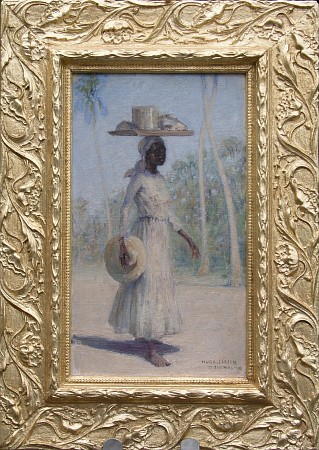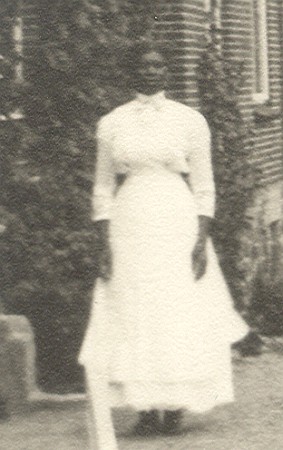
Hugo Larsen: Travelling Rachel, St. Thomas 1906

Rachel Ann Proctor, 1914
This small article is an attempt to gather the little information we have of Rachel Ann Proctor, born appr. 1888 on Anegada, British Virgin Islands. At the same time, it is an inquiry for more information that may help us to a better understanding of Rachel Proctor's life and family.
My interest in Rachel Proctor originates from the painting to the left. It was painted by Hugo Larsen in the Danish West Indies. Until now this is the only painting portraying people of colour where we know the name of the portrayed. The painting has its own history, described in the article Travelling Rachel.
As mentioned, Rachel Proctor was born appr. 1888 (more precisely between 25 Oct 1887 and 27 Apr 1888) on Anegada - "the drowned island" - the furthest east of the British Virgin Islands, a low lying coral island with few job opportunities besides fishing and treasure recovery from shipwrecks around the island. A number of immigrants from Anegada came to St. Thomas a hundred years ago, among them Rachel Proctor.
Rachel Proctor came to St. Thomas in 1896. In 1911 she lived with an uncle, the merchant Samuel Witmore Proctor, and his family. By then she had a little son aged 1½ years, Viggo Ivan Moron. We do not know who his father was and his fate is unknown. Perhaps Rachel's own fate as a nanny can be seen in the light of her having lost her own son for which reason she transfers all her love to other people's children.
Rachel becomes nanny for the children of Reimund Baumann and his wife Margaret Ingeborg née Bache. The couple gets married in December 1908 and gets three children during the years 1909 to 1920. Baumann is police master and judge in Christiansted and later becomes secretary to the governor until he is appointed Danish consul-general after Transfer Day in 1917. Margaret was daughter of merchant in St. Thomas J. William Bache.
Being a nanny becomes Rachel Proctor's mission in life. She loves the children and they love her in return. A life-long mutual love. She follows them everywhere and naturally she accompanies the family on the visit to New York in 1918.
When Baumann has completed the obligations of the Danish administration, the family and Rachel return to Denmark in the spring of 1920, but not for long. In 1921, Baumann is appointed consul-general in Chicago and the family crosses the Atlantic again. This time as always with Rachel accompanying the family. The children grow up in Chicago and they eventually leave the home. But Rachel stays. And when Baumann's son Harald marries and gets children of his own, Rachel becomes nanny for the next generation.
Rachel became a member of the Baumann family and there is no doubt that she was venerated by the family and its friends. This is obvious from the frequent greetings to her in letters to the family. But the strongest indication is perhaps in a document signed in 1959 where Vilma Baumann - a daughter of the Baumanns and by the time still unmarried - establishes Rachel as beneficiary in her life assurance.
This is what we know so far about Rachel Proctor's life. The sole additional information that we have about her family is that she in 1920 informs that her closest relative is an uncle J. Proctor in St. Thomas. Perhaps this is the same person as the above mentioned Samuel Witmore Proctor.
Any supplementary information about Rachel Proctor and her family is warmly welcomed. Who were her parents? Who is the mentioned uncle J. Proctor in St. Thomas? Was she a servant to the Bache family in St. Thomas before becoming a nanny for the family Baumann? Did she eventually leave the family? When and where did she die?
Thanks to my good friend Dante Beretta for his valuable help with finding information about Rachel Proctor.
See also:
The story of the painting Travelling Rachel.
A larger reproduction of the painting.
The artist Hugo Larsen. Of particular interest is the virtual gallery of his West Indian paintings, the West Indian drawings and the description of his 3½ years in the Danish West Indies.